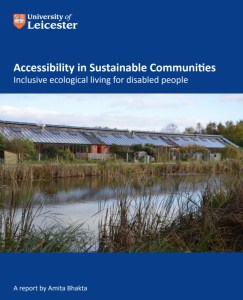 Can homes be both eco-friendly and accessible? If not, it means people with disability and older people are excluded from the benefits of an eco-home. Part M of the UK building regulations require a level threshold and a downstairs toilet. The Lifetime Home standard provides for more flexibility for adaptation. Accessible eco homes are possible with the help of designers
Can homes be both eco-friendly and accessible? If not, it means people with disability and older people are excluded from the benefits of an eco-home. Part M of the UK building regulations require a level threshold and a downstairs toilet. The Lifetime Home standard provides for more flexibility for adaptation. Accessible eco homes are possible with the help of designers
A study by Amita Bhakta found the following issues with the eco home movement:
-
- Sustainability has overridden accessibility in sustainable communities in the UK.
- Disability requires greater understanding that it is more than mobility impairment.
- Space beyond the home should be included in the meaning of home.
- Top-down policy is not enough – co-design is required.
- Planners, architects and builders in eco-housing do not consider bodily differences.
The title of the report available from Academia.edu is Accessibility in Sustainable Communities. It includes a discussion about whether sustainable communities should cater for all needs. But Bhakta points out that sustainable communities cannot regard themselves as progressive if they are exclusive. The report concludes with a model for inclusive sustainable communities. See abstract below.
There is a similar article, Making space for disability in eco-homes and eco-communities. The eco-home movement in the UK is underpinned by collaborative and communal housing and living. The aim of the movement is to minimise environmental impact and to be socially progressive.
From the abstract
We use three eco-communities in England to explore how their eco-houses and wider community spaces accommodate the complex disability of hypotonic Cerebral Palsy.
We used site visits, video footage spatial mapping, observations, survey and interviews that show little attention has be paid to making eco-houses accessible. There are four ways to interrogate accessibility in eco-communities: understanding legislation, thresholds, dexterity and mobility.
Three factors emerged: ecological living is not designed for disabled people; disabled access was only considered in relation to the house and its thresholds and not to the much broader space of the home; and eco-communities need to be spaces of diverse interaction.
